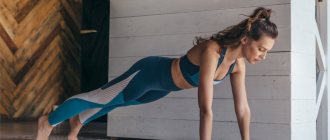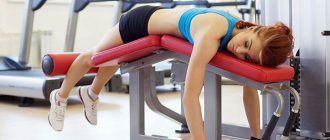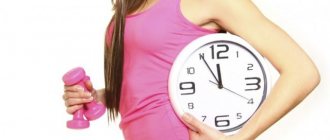September 6, 2012
Can't decide when it's better to exercise: in the morning, before work, or in the evening - after? Find out what the experts advise.
Many people choose the time to exercise based on their busy work schedule. However, such training sometimes does not bring the desired results and quickly disappoints. Is there an ideal time to exercise? Studies of the relationship between the effectiveness of exercise and time of day often lead to conflicting results. Let's try to clarify.
How do circadian rhythms affect training?
The human sleep-wake cycle is called the circadian rhythm.
It is this cycle that regulates body temperature, blood pressure, metabolism and many other physiological processes of the body. Circadian rhythms: setting the internal clock
All living things have an internal clock. Find out where they are and how to set them in the article “What are Circadian Rhythms.”
As a rule, these rhythms are subject to a 24-hour day, but can change under the influence of environmental signals. The time at which a person usually exercises is one such signal.
Night training
The least popular time to exercise is at night. Although, if you pay attention to how hormones behave at night, such training also has a place.
Pros and cons of night training
+ Favorable hormonal balance. Testosterone
, such an important anabolic hormone, is actively produced from eight o'clock in the evening and reaches its peak in the morning. At night, testosterone is at an average level.
Cortisol
, the main enemy of effective training, reaches its minimum at night.
Somatotropin
, or growth hormone, is at its peak at night, which has a positive effect on building muscle mass.
— Sleep disorders, insomnia
After training, the human body is in an overexcited state for several hours and it is simply impossible to fall asleep. But during intense sports, recovery requires at least 7-9 hours of full sleep. If a person chooses night training for himself, he should take care of restructuring his sleep and awakening patterns.
Don't miss interesting news and events in the telegram channel: https://tlgg.ru/fitbarnews
Changing the rhythms
Research shows that a person can change their circadian rhythm, for example by waking up to an alarm and eating at the same time. Scientists have also found that people who consistently exercise in the morning can “teach” their body to be ready for physical activity at that time of day. Volunteers who were used to working out in the morning felt less strong and focused during the evening workouts. Experts say that this rhythm adjustment is especially important for athletes who are preparing for specific competitions. They recommend rescheduling training for the exact time of day when the competition will take place.
Early Morning Strength Training: What You Need to Know
What to do if early morning is the only time you can go to workout? Are there any restrictions?
Early morning workouts and nutrition
In the morning after sleep, the body has low glucose levels. Exercising with low glucose levels can lead to temporary hypoglycemia - reducing it even further. You may feel nausea, weakness, dizziness and lightheadedness.
In the morning, the secretion of cortisol, a catabolic hormone, also peaks.
Cortisol is a stress hormone that provides glucose to the nervous system, extracting it from body proteins and fats.
The cortisol antagonist is insulin. When insulin levels rise, cortisol decreases. So eating something before going to work out is a good idea. In addition, research shows that carbohydrates and proteins eaten immediately before a morning workout have a greater anabolic effect. It is slightly higher than eating before a daytime or evening workout, when amino acids, fats or glucose from previous meals are already in the blood.
Some people don't like to exercise on a full stomach. They feel heaviness and drowsiness, and it is more difficult to exercise. In fact, it takes very little to raise blood glucose. Lyle MacDonald gives the following figures:
- 0.3-0.4 grams of both protein and carbohydrates per kilogram of body weight. For a girl weighing 55 kg, this is 16-20 grams of both.
So you don't have to binge on breakfast before your workout if you don't want to. In this case, food in liquid form would be a good solution: it is absorbed faster and does not create a strong feeling of fullness and heaviness in the stomach. Milk, yogurt, protein powder, fruit may help. The stomach will not be full, but the body will receive everything it needs.
Early morning workouts and joints
Your joints are immobile while you sleep. During this time, the production of synovial fluid decreases. This fluid lubricates the joints to help them move freely. In addition, the body temperature is lower in the morning, and this also makes the muscles and ligaments more rigid. Therefore, a quality warm-up is very important.
Morning workouts and spine
There are studies that most people show better results in training 3 hours after waking up. During this time, you warm up in various everyday movements, your joints restore elasticity and mobility. But not everyone can afford it, which can be a problem. Dr. Stuart M. McGill writes about this in his book Ultimate Back Fitness and Performance.
When you sleep in a lying position, the compression (squeezing) load on the intervertebral discs decreases. This allows the discs to absorb more liquid and expand in volume. In the morning, the pressure inside the discs is 240% higher than before bedtime, and the likelihood of protrusions, hernias or damage to the ligaments increases at this time. If possible, avoid heavy deadlifts, Romanian deadlifts, and squats if you're training less than an hour after waking up.
During the day, excess water comes out as a result of normal household load. The discs become more rigid in compression, but at the same time more flexible. The likelihood of them being damaged becomes less.
If you don't have the option to wait a couple of hours after getting up before exercising, here are some solutions. They reduce the risk of spinal injuries during morning exercise.
1
Hot shower or sauna
This is one of the passive warm-up methods - a way to warm up soft tissues and make them more elastic.
2
Longer warm-up
The longer you warm up and stretch, the more excess fluid will be released from the discs before you begin strength training. Running fast early in the morning without preparing the body is also not recommended. The best option is walking on a path uphill, joint warm-up and dynamic warm-up for the mobility of the main joints. If you usually warm up for 10 minutes, double the time.
3
Do warm-up sets
Don't start straight away with heavy barbell exercises. Instead, do a longer series of warm-up sets with light weights.
4
Do one-legged exercises
Give preference to exercises performed on one leg. Lunges, split squats, step-ups, single leg rows, etc. In them, the load on the lower back is less, and the activation of the target muscles is just as good.
5
Abdominal exercises - at the end of the workout
Flexion-extension of the spine is especially dangerous when the discs are oversaturated with water. Even safe exercise can be harmful under these conditions. Therefore, do all crunches at the end of your workout.
Individual differences
Despite the presence of a 24-hour circadian rhythm, people peak in physical fitness at different times. For some, it is natural to exercise in the morning. Moreover, at this time in cities the air is much cleaner and cooler, and there are fewer cars and passers-by. Others feel too sleepy in the morning, but enjoy studying in the evening. However, experts believe that regardless of personal preference, almost all people are physically stronger and more resilient in the afternoon
.
Activity distribution
Let's look at what time you can and should train, taking into account the arrow on the dial:
- 05:00. Body temperature is low. This time is suitable for light training (yoga, warm-up).
- 07:00. Morning activity will energize the cardiovascular system and speed up fat burning. Studies have shown that the number of calories burned when exercising in the morning is three times greater than in the evening.
- 15:00. Running in the fresh air strengthens the body. At this time, the heart copes with pumping blood more easily, joints become flexible, and the temperature rises.
- 16:30. This time is suitable for cycling. Pedaling guarantees fat burning (especially in women). The advantage is muscle flexibility, liquid blood.
- 17:00. Working with loads. The body heats up to the maximum temperature. If you pump at this time, you can achieve high testosterone levels. It is believed that after 17:00 a second wind opens in the body.
- 19:00. At this time, it is worth giving yourself to swimming. This can be explained by the activity of reflexes and muscle plasticity.
- 20:00. Evening time is suitable for team sports.
Recommendations for people with chronic pathologies
Physical activity has a positive effect on the health of people with chronic pathologies, including:
- oncological diseases;
- arterial hypertension;
- diabetes mellitus type 2;
- HIV infection.
These people should maintain the recommended level of physical activity for their age, including moderate-to-vigorous aerobic exercise and strength and balance exercises. The intensity and duration of exercise can be gradually increased if there are no contraindications.
Recommendations for adults 18 to 64 years old
moderate- and vigorous-intensity physical activity
.
It is recommended to devote at least 2-5 hours a week
, and at least
1.5-2.5 hours
. It is not necessary to go to fitness centers; dancing or sports classes are perfect. As an additional load, it is worth choosing the optimal set of strength exercises for all muscle groups and conducting at least 2 workouts per week.
The indicated duration and intensity of training can be considered minimal. Adults can increase the duration of daily activities or make them more intense. It is worth remembering that if you previously did not devote enough time to physical activity, then it is better to increase its level gradually so that it does not turn out to be too much stress for the body.
A sedentary lifestyle in adults can contribute to:
- increased mortality;
- increased risk of developing cardiovascular and cancer diseases, as well as type 2 diabetes;
How to calculate heart rate for sports
The abbreviation HR stands for “heart rate,” in other words, it is the pulse. The easiest way to measure it is to place your finger on your wrist about 3-5 cm below the bend of the hand and count your heart rate for 15 seconds. Multiply the result by 4 to get the number of heartbeats per minute.
The same work can easily be done by modern fitness bracelets and smart watches. If you just started playing sports, these devices will help you track your daily activity and heart rate.
Measuring your pulse during exercise is very important: this allows you to understand how your heart reacts to physical activity and prevent overload.
In an adult, the resting pulse should vary from 60 to 80 beats. When under load, the norm is considered to be up to 200 beats - and the figure of 100-130 beats per minute belongs to the zone of moderate loads, during which fat is intensively burned. 130-170 beats per minute are already intense loads that are suitable for training the heart. Above are high-intensity workouts, which are stressful for the body. You can only exercise with such a pulse under the guidance of an experienced trainer.
Please note that your heart rate may be higher if you exercise in a stuffy room, get sick, or drink coffee shortly before your workout. In this case, monitor your well-being - the higher the pulse, the harder the load is tolerated.
I should exercise in the morning when:
- I work until late at night and am very tired. By working out in the morning, you can be sure that no work, family matters or fatigue will interfere with your workout.
- I do not get enough sleep. For sound sleep, you should avoid physical activity at least 2 hours before going to bed.
- When I wake up, I feel exhausted. Exercise is a great way to cheer up.
- I get up early and go to bed early. Morning workouts are great for early risers. At this time, your body independently prepares for the load.
How to overcome the Lizard's resistance to physical activity
Physical activity in the morning: How to strengthen the health of your brain and body Photo: Depositphotos
We hope you already understand what conclusion we are bringing you to: physical exercise requires leaving your comfort zone, and the Lizard does not want this. Exercises should not be performed forcefully. They should be done for fun. It will be much easier to fall in love with physical activity if you fully appreciate its usefulness. It won't be easy at first, and you will definitely encounter resistance.
Let me suggest a few little tricks to help overcome your Lizard's aversion to exercise:
Make the necessary preparations
The day before your workout, have your workout clothes, water, and pen and paper (or smartwatch) ready to record your progress. Put everything in a visible place, then you can start exercising at the appointed time, without being distracted by searching for the necessary things.
Seek praise
Try to provide positive feedback and encouragement from your family and friends. Don't be afraid to ask them to praise you. Recognition of our achievements by others inspires us to further advance along the path of self-development. Publishing your results on social networks will definitely attract the attention of your friends and bring a lot of likes. You may even make someone want to join you: remember that you are not the only person with a Lizard inside. Self-praise is even more powerful. It not only helps you enjoy exercise, but also improves your self-esteem. Keep a journal of your achievements and write down everything you have done - give yourself credit for your hard work.
Visualize your success
The mental image of yourself created from past experiences may be powerless and unable to help you change anything. However, you should not cling to your yesterday's self. The first step to change begins in your mind. Using visualization, start creating a new version of yourself right now. The essence of the method is simple: by imagining yourself training and achieving a goal, you mentally practice body movements before you begin real actions, and create pathways in the brain necessary to improve the efficiency of the nervous system, heart and respiratory organs.
As we have already said, visualization is a powerful tool for making internal changes. For example, many track and field athletes use it not only to achieve their goals in competitions, but also when they simply want to improve their performance. Experts from the Center for Sports Research and Innovation at the University of Lyon in France confirmed that when athletes visualize the exercise beforehand during training, they show better results.
The visualization is similar to the construction of a bypass road to relieve traffic jams in the city center during peak hours. In this context, “downtown” refers to the many barriers to successful exercise planning.
The technique for increasing the efficiency of visualization includes the following steps:
- First you need to set a clear goal. It should have a specific, measurable outcome, such as losing 5 kilograms and scheduling 30 minutes of physical activity three to five times a week. Write down a detailed description of your goal.
- Find a place where you won't be disturbed for five minutes.
- Lie down comfortably or sit on a chair with your back straight. You can turn on relaxing background music. Close your eyes and take five to six deep, long, slow breaths. Breathe longer if necessary: To get the most out of your visualization, you need to clear your mind.
- Start imagining how you will feel when you achieve your goal. For added effect, try to involve all your senses in the process.
- Take a look at your new healthy body and take a mental selfie.
- Hear congratulations from loved ones.
- Imagine how you will feel when you touch your slimmer body, and what joyful emotions will overwhelm you after achieving your goal.
- Feel the life-giving taste of the water you drink after your workout. And the smell of labor sweat!
- The more detail you can add to your visualization, the more effective it will be.
- To make your visualization even more powerful, add vigorous movement and vibrant colors to your mental picture. For example, imagine yourself jumping around in a colorful T-shirt to celebrate your victory.
- Hold this picture in your mind for 30 to 45 seconds, or for as long as you can keep it in your focus.
- If concentration quickly disappears, do not be upset and simply restore the picture. To do this, use the detailed description of the goal compiled earlier. It will help you whenever you are distracted.
- Repeat this five-minute visualization exercise every morning for at least seven days.
- Visualization can be done in between different physical exercises. This will allow you to get additional benefits from your workout.
Train with a friend
Exercising with a friend or family member will give you a boost of inspiration that is difficult to get when exercising alone. A study conducted at Michigan State University found that group training increased participants' motivation. Exercising together increases motivation not only for you, but also for your partner. Many people find it much easier to come to the gym if they know that a friend who is counting on them will be there waiting for them.
Additional benefits of training together include an inspiring fun atmosphere and a friendly competitive spirit that can push you to overcome barriers you might not be able to overcome on your own. You just need to find someone who is willing to get up early enough to work out with you, or choose a time that works best for both of you.
Blood pressure and sports
Normally, a person’s blood pressure should be approximately 120/80. But people who lead a healthy lifestyle may have lower blood pressure - for example, within the normal range, blood pressure is 100/60.
Sports are not contraindicated for people with hypertension - but they need to carefully monitor the level of stress and start exercising in a gentle manner. You can start with walking - first accustom yourself to walking more, then increase the pace. Later you can switch to running or swimming.
It is better to start training after consulting with your doctor.
IMPORTANT! If your blood pressure exceeds 190\110 at least periodically, if during physical activity you experience a burning sensation or pressure in the chest, intensive training, unfortunately, is contraindicated for you. But you can do static exercises, such as yoga.
The relevance of the problem of lack of physical activity
Regular physical activity
- one of the key factors in preventing non-communicable diseases, maintaining mental health, optimal weight and improving overall well-being. However, WHO notes that globally, about 30% of adults and 80% of children do not comply with the 2010 recommendations and continue to lead a sedentary lifestyle. “Distortion” is also observed along gender lines. In particular, in many countries, girls and women are less active than boys and men. Differences in the level of physical activity are also noticeable in terms of regions of residence and social status.
Let's consider WHO recommendations regarding physical activity for people of different ages, including those with disabilities.
Results
Now let's summarize for each time:
- Morning. Features: increased testosterone levels, decreased body temperature, minimal serotonin levels, the brain is active and concentrated. Advantages: increased oxygen volume, availability of exercise equipment, no workload in the gym.
- Day. Features - temperature and adrenaline rise, the sensitivity threshold increases, energy level drops. Advantages: availability of daylight, increased rest time between sets, availability of a trainer.
- Evening. Features: Temperature, endurance and coordination at peak. In the evening, lung performance is at its maximum level, joint strength and bone flexibility increase, and mental concentration decreases.
If the goal is to lose weight, then the morning hours guarantee results. Due to the high level of cortisol and other hormones, metabolic processes are activated and excess fat is burned more quickly. In this case, both light jogging and strength training are allowed. The main thing is not to put too much pressure on the body, but to listen to its sensations.
Recommendations for children and adolescents from 5 to 17 years old
at least an hour of moderate-to-vigorous intensity physical activity
, it is better to focus on aerobic exercise. In addition, it will be useful to perform exercises aimed at strengthening the musculoskeletal system.
A sedentary lifestyle in children and adolescents can contribute to:
- development of obesity;
- increased risk of developing cardiovascular diseases;
- reduction in sleep duration;
- deterioration of emotional state.











